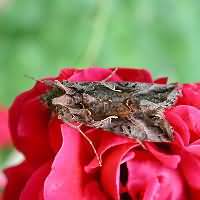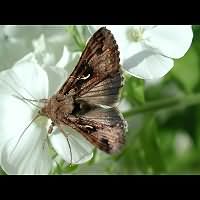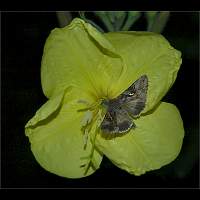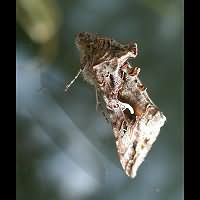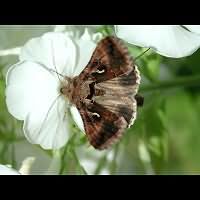Silver Y Autographa gamma
The Silver Y is among the best known moths. Identification is easy thanks to the silvry white Y on the front wing. The remainder of the front wings is brownish, the rear wings are grey at first, but become dark grey towards the end of the wings. There are a few look-a-likes, such as the Ni Moth. The Ni Moth however is smaller, more greyish than brownish, the shape of the white marking differs and it usually runs further up the wing. The Scarce Silver Y is also similar to the Silver Y, but it too is smaller and the white spot is interrupted, thus giving the impression of a question mark rather than a Y. The Essex Y is also similar, but it's Y is well less marked and the hind wings are rather brownish and more unicoloured. In Northern parts of Britain you may encounter the Scarce Silver Y. Chances are extremely small you'll ever really see the Essex Y and the Ni Moth, for both are rare visitors to Britain indeed. The Silver Y has another distinctive character: when it is not at rest it is flickering its wings constantly. Very variable in size. The wingspan may be only 30 mm, but can be well over 50 mm as well.
The eggs are laid from May onwards, usually individually on the underside of leaves. The development of this species is very dependable on weather conditions, especially the temperature. In warm summers it may take just 7 weeks for the next generation of adult moths to appear. The caterpillars may be found until the first night frost. That's something they can't survive. The basic colour of the larvae of the Silver Y is variable and runs from yellowish green to almost black. Usually a dark line runs over the back, bordered by two thin and curved whitish lines. A yellow line runs over the sides. Often the back shows small circles, which look like spiracula very much. The real legs are brownish and the head is greenish. The caterpillar has only three pair of prolegs, thus sometimes considered to be a Geometer by mistake. The larvae reach a length of some 30 to 40 mm. The caterpillars will eat almost any low growing plant, including many garden varieties. Sometimes becomes a plague on cabbage and peas. Pupation takes place in a silvry cocoon attached to the underside of a leaf.
An adult Silver Y rarely survives winters in Central and Northern Europe. It is a true migrant invading all of Europe in summer from Southern Europe. The first appear in May usually, the last are seen in October. In summer the number of animals rises sharply as migrants are accompanied by animals born over here. From August onwards the Silver Y may appear in very great numbers. Even though most animals are active during the night, many also appear in broad daylight. When visiting flowers they join the Admirals, Peacocks and Whites. Due to their brown colour, relatively small wings, plump body and rather nervous behaviour they are very striking indeed. At night it is attracted to both light and sugar. A very common species all over Europe, up to and including the Polar circle. Common all over Britain and in the south of England often seen abundantly.
This species is also known as the Silver Y Moth.
The Silver Y is among the best known moths. Identification is easy thanks to the silvry white Y on the front wing. The remainder of the front wings is brownish, the rear wings are grey at first, but become dark grey towards the end of the wings. There are a few look-a-likes, such as the Ni Moth. The Ni Moth however is smaller, more greyish than brownish, the shape of the white marking differs and it usually runs further up the wing. The Scarce Silver Y is also similar to the Silver Y, but it too is smaller and the white spot is interrupted, thus giving the impression of a question mark rather than a Y. The Essex Y is also similar, but it's Y is well less marked and the hind wings are rather brownish and more unicoloured. In Northern parts of Britain you may encounter the Scarce Silver Y. Chances are extremely small you'll ever really see the Essex Y and the Ni Moth, for both are rare visitors to Britain indeed. The Silver Y has another distinctive character: when it is not at rest it is flickering its wings constantly. Very variable in size. The wingspan may be only 30 mm, but can be well over 50 mm as well.
The eggs are laid from May onwards, usually individually on the underside of leaves. The development of this species is very dependable on weather conditions, especially the temperature. In warm summers it may take just 7 weeks for the next generation of adult moths to appear. The caterpillars may be found until the first night frost. That's something they can't survive. The basic colour of the larvae of the Silver Y is variable and runs from yellowish green to almost black. Usually a dark line runs over the back, bordered by two thin and curved whitish lines. A yellow line runs over the sides. Often the back shows small circles, which look like spiracula very much. The real legs are brownish and the head is greenish. The caterpillar has only three pair of prolegs, thus sometimes considered to be a Geometer by mistake. The larvae reach a length of some 30 to 40 mm. The caterpillars will eat almost any low growing plant, including many garden varieties. Sometimes becomes a plague on cabbage and peas. Pupation takes place in a silvry cocoon attached to the underside of a leaf.
An adult Silver Y rarely survives winters in Central and Northern Europe. It is a true migrant invading all of Europe in summer from Southern Europe. The first appear in May usually, the last are seen in October. In summer the number of animals rises sharply as migrants are accompanied by animals born over here. From August onwards the Silver Y may appear in very great numbers. Even though most animals are active during the night, many also appear in broad daylight. When visiting flowers they join the Admirals, Peacocks and Whites. Due to their brown colour, relatively small wings, plump body and rather nervous behaviour they are very striking indeed. At night it is attracted to both light and sugar. A very common species all over Europe, up to and including the Polar circle. Common all over Britain and in the south of England often seen abundantly.
This species is also known as the Silver Y Moth.

